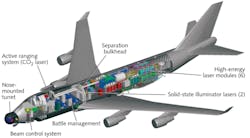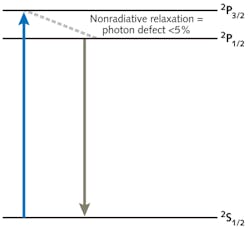PHOTONIC FRONTIERS: MILITARY LASERS: A new generation of laser weapons is born
![FIGURE 1. a) Airborne Laser (right) fires its 1.3-µm beam at a SCUD missile (left) an unspecified distance away. The other images show the target missile breaking up; the sequence goes from b) to d). All images were taken in the infrared. [For a video, see http://www.mda.mil/global/videos/altb/vm424_altb_11_feb_10.wmv. See also http://www.mda.mil/news/gallery_altb.html.] FIGURE 1. a) Airborne Laser (right) fires its 1.3-µm beam at a SCUD missile (left) an unspecified distance away. The other images show the target missile breaking up; the sequence goes from b) to d). All images were taken in the infrared. [For a video, see http://www.mda.mil/global/videos/altb/vm424_altb_11_feb_10.wmv. See also http://www.mda.mil/news/gallery_altb.html.]](https://img.laserfocusworld.com/files/base/ebm/lfw/image/2016/01/16601.res.png?auto=format%2Ccompress&w=250&width=250)
Plans are changing for laser weapons development following three crucial demonstrations. Early in 2009, a diode-pumped solid-state slab laser from Northrop Grumman (Redondo Beach, CA) emitted 100 kW continuously for five minutes. This February, Textron Defense Systems (Wilmington, MA) also exceeded average power of 100 kW with a different diode-pumped solid-state laser design. The same month, the megawatt-class Airborne Laser (ABL) successfully completed the long-shot shoot-down of a liquid-fueled SCUD ballistic missile, representative of potential enemy threats (see Fig. 1).
On the surface, all three demonstrations sound like welcome good news. The ABL became the first laser to destroy a foreign-built ballistic missile in flight, a key milestone for missile defense. The Northrop Grumman and Textron demonstrations met milestones for development of solid-state laser weapons established by the Joint High-Power Solid-State Laser (JHPSSL) project managed by the Pentagon's Joint Technology Office.
Yet the fiscal 2011 budget puts the brakes on further development of the chemical oxygen/iodine laser (COIL) technology used in ABL, while including money to develop new laser technology and convert the 747-mounted laser into a testbed to study high-energy laser effects. In contrast, the budget does include plans for field trials to test potential of electrically powered 100-kW class lasers for battlefield use against rockets, mortars, artillery, and small boats.
Missile defense problems
The Airborne Laser is the latest in a series of laser missile-defense projects that began in the Carter Administration. The Defense Advanced Research Projects Agency's (DARPA) Space Laser Triad included construction of a 5 MW hydrogen-fluoride (HF) chemical laser on the ground, called Alpha, to show feasibility of orbiting laser battle stations to block a massive Soviet nuclear attack. Ronald Reagan's Strategic Defense Initiative expanded on the idea, proposing a layered defense and alternatives including pop-up bomb-driven x-ray lasers. Alpha eventually reached megawatt-class power in 1991, but the end of the Cold War and formidable problems with laser and space technology led to shifts in plans.
The ABL program was born in 1993 to defend against a more manageable missile threat—launch of a handful of missiles by "rogue states" such as North Korea. The plan was to install a megawatt laser in a plane that could fly close enough to potential launch sites that it could destroy missiles during their vulnerable boost phase. Developers hoped that use of a 1.3 µm COIL laser would help overcome beam-propagation problems, as well as allow smaller beam-direction optics than needed for HF/DF chemical lasers.
In 1996, the Pentagon issued Boeing a $1.1 billion contract to build the ABL, with lethality tests starting in the early 2000s. The Bush Administration designated ABL (see Fig. 2) as the boost phase element of a multilayer missile defense system, but the planned missile shoot-down fell years behind schedule and ran billions of dollars over budget.Last Spring, Secretary of Defense Robert Gates pulled the plug on plans to build a fleet of ABLs before completing tests. He told Congress that the laser's projected lethal range was only 85 miles (135 km), well short of the 200 km sought for boost-phase missile defense. Next year's proposed budget, unveiled in February, calls for converting the ABL into a testbed to study laser effects in the air and on the ground. A new "Directed Energy Research" budget line will split $95 million between ABL tests and development of new types of lasers, but a Missile Defense Agency (MDA) spokesperson did not know how the money will be divided.
The MDA did not disclose the laser's range in its February tests, but it had planned to start with close-in targets and move to more distant targets and more difficult missions. The first successful shoot-down was of a sounding rocket on February 3. The ABL shot down the SCUD on February 11, locking onto it within seconds after launch, then measuring atmospheric distortion and compensating for it before firing the COIL, which caused structural failure of the missile within two minutes of launch. Within an hour, ABL tracked and engaged a boosting solid rocket, showing it could be fired repeatedly. The second missile was not destroyed because of a "beam misalignment," according to Aviation Week.1 The MDA plans further tests into the summer, which may include countermeasures and multiple missiles to assess system response. Important issues yet to be addressed in public include the laser's ability to operate at full power in flight and how well the optics can withstand full-power operation.
Diode-pumped alkali lasers
The MDA's fiscal 2011 budget proposal identifies diode-pumped alkali lasers as the leading candidate for missile defense. Their big attractions include thermal management in a vapor phase rather than a solid, potentially extremely high optical to optical conversion efficiency, a good match to near-infrared pump diodes, very high power per unit volume, and running on electrical power instead of requiring special chemical fuels.
William Krupke, a long-time deputy associate director of the laser program at the Lawrence Livermore National Laboratory (Livermore, CA), proposed and patented diode-pumped alkali vapor lasers after retiring to become a consultant. He focused on three-level laser systems based on transitions of the single valence electron (see Fig. 3). The diodes pump an absorption line of the neutral-atom 2S1/2 ground state, exciting it to the 2P3/2 state. Collisions with a buffer gas relaxes that state rapidly to the lowest excited state, 2P1/2, which is the upper laser level. Intense pumping by a diode array produces a population inversion with extremely high small-signal gain.The photon defects are remarkably small, only 4.7% in cesium, 1.9% in rubidium, and 0.44% in potassium, so optical-to-optical slope efficiency can in theory exceed 95%. Careful engineering is needed to approach those levels. At low pressure the alkali metals have very narrow linewidth, so buffer gases are added to match the absorption band with the 2 nm emission band of the diode array. Experimental slope efficiencies have exceeded 80%.2, 3
The alkali vapors are "an unusual kind of gain medium," Krupke says. With radiative lifetimes of only 30 ns, they don't count as energy-storage media in the normal sense. "This is a quasi-two-level laser. The more you pump, the less ground state atoms there are to absorb, so you have to stimulate emission to get atoms back to the ground."
Experiments are still in the early stages, but published power levels have already reached tens of watts in static systems. Most early experiments were with longitudinal pumping, but at SPIE's Photonics West (San Francisco, CA) in January, Jason Zweiback and A.M. Komashko of General Atomics Aeronautical Systems (San Diego, CA) showed that transverse pumping is promising for higher powers. In addition to giving more pump area, transverse pumping geometrically separates the closely spaced pump and emission wavelengths, which are hard to separate when they are aligned along the laser axis.
Waveguide structures might allow kilowatt output, but flowing systems promise much higher power by removing heat. New engineering techniques are needed to take advantage of the unusual system, but it's getting major attention at General Atomics, Livermore, the US Air Force Academy, and elsewhere.
Diode-pumped solid-state lasers
The two JHPSSL demonstrations have put diode-pumped slab geometries at the forefront of battlefield laser development. The next steps are testing their performance and engineering such lasers for mobile platforms—aircraft, ships, and trucks.
In February, the Army announced it would move the 105 kW Northrop Grumman laser from the company's lab to the High Energy Laser System Test Facility at White Sands Missile Range (New Mexico), where it will undergo extensive testing.4
General Atomics is building a 150 kW laser for DARPA's High-Energy Liquid Laser Area Defense System (HELLADS), with target weight less than 5 kg per kW of output in a laboratory demonstration version. The long-term goal is developing a laser weapon for tactical aircraft.5
Northrop Grumman is building the Maritime Laser Demonstration system, another diode-pumped solid-state laser, which will be demonstrated at sea.6 Goals are to protect ships from threats such as small boats.
Diode pumping doesn't have a monopoly in tactical laser weaponry. The Navy is designing a 100 kW class free-electron laser weapon system for use on ships, in the hope that a free-electron laser could zap low-value targets at lower cost than expensive missiles.7 Planners envision eventual megawatt powers.
Fiber lasers also may find battlefield uses, although their limited powers so far seem best suited for detonating unexploded ordnance or land mines. But effective techniques for coherent beam combination could deliver more power to potential targets, expanding their uses.
Issues and outlook
Laser weapons have always been a tough challenge, and delivering a lethal dose of laser energy to the target has proved even harder than building the laser itself. The longer the propagation distance, the bigger the beam-delivery problem. So it is not surprising to see the Pentagon shift its priorities to lower-power, shorter-range laser weapons. Diode-pumped solid-state lasers can generate 100 kW class outputs, powerful enough to block attacks by the rockets, artillery, mortars, and small boats favored by insurgents. Moreover, they can run from diesel generators that already are standard field equipment.
Major challenges remain. Optical damage is a critical issue, particularly in the inevitably dusty and dirty environment of a battlefield. Prototype solid-state lasers have used laboratory chillers to control thermal effects; practical versions will require ruggedized versions that can operate in the field. Other components also require ruggedization and costs must be reduced.
Building megawatt-class lasers and delivering their beams to targets hundreds of kilometers away are even more formidable problems. Diode-pumped alkali-vapor lasers are attractive because they promise very high efficiency, and flowing-gas versions might scale to generate a megawatt from a single aperture. Generating a megawatt from a solid-state laser would require coherent combination of beams from many separate apertures, and that technology is in its infancy.
REFERENCES
- Amy Butler, "Ray of Light," Aviation Week & Space Technology, p. 28–29 (Feb. 22, 2010).
- B.V. Zhdanov, R.J. Knize, "Progress in alkali laser development," Proc. SPIE 6874, p. 68740F (2008.doi:10.1117/12.769064).
- W.F. Krupke, "Diode pumped alkali lasers (DPALs): An overview," Proc. SPIE 7005, p. 700575 (2008.doi:10.1117/12.782466).
- http://www.smdc.army.mil/FactSheets/HELSTF.pdf
- http://www.darpa.mil/tto/programs/hellads/
- http://www.onr.navy.mil/en/Science-Technology/Departments/Code-35/All-Programs/aerospace-research-351/Maritime-Laser-Demonstration.aspx
- http://www.onr.navy.mil/en/Media-Center/Fact-Sheets/Free-Electron-Laser.aspx

Jeff Hecht | Contributing Editor
Jeff Hecht is a regular contributing editor to Laser Focus World and has been covering the laser industry for 35 years. A prolific book author, Jeff's published works include “Understanding Fiber Optics,” “Understanding Lasers,” “The Laser Guidebook,” and “Beam Weapons: The Next Arms Race.” He also has written books on the histories of lasers and fiber optics, including “City of Light: The Story of Fiber Optics,” and “Beam: The Race to Make the Laser.” Find out more at jeffhecht.com.

